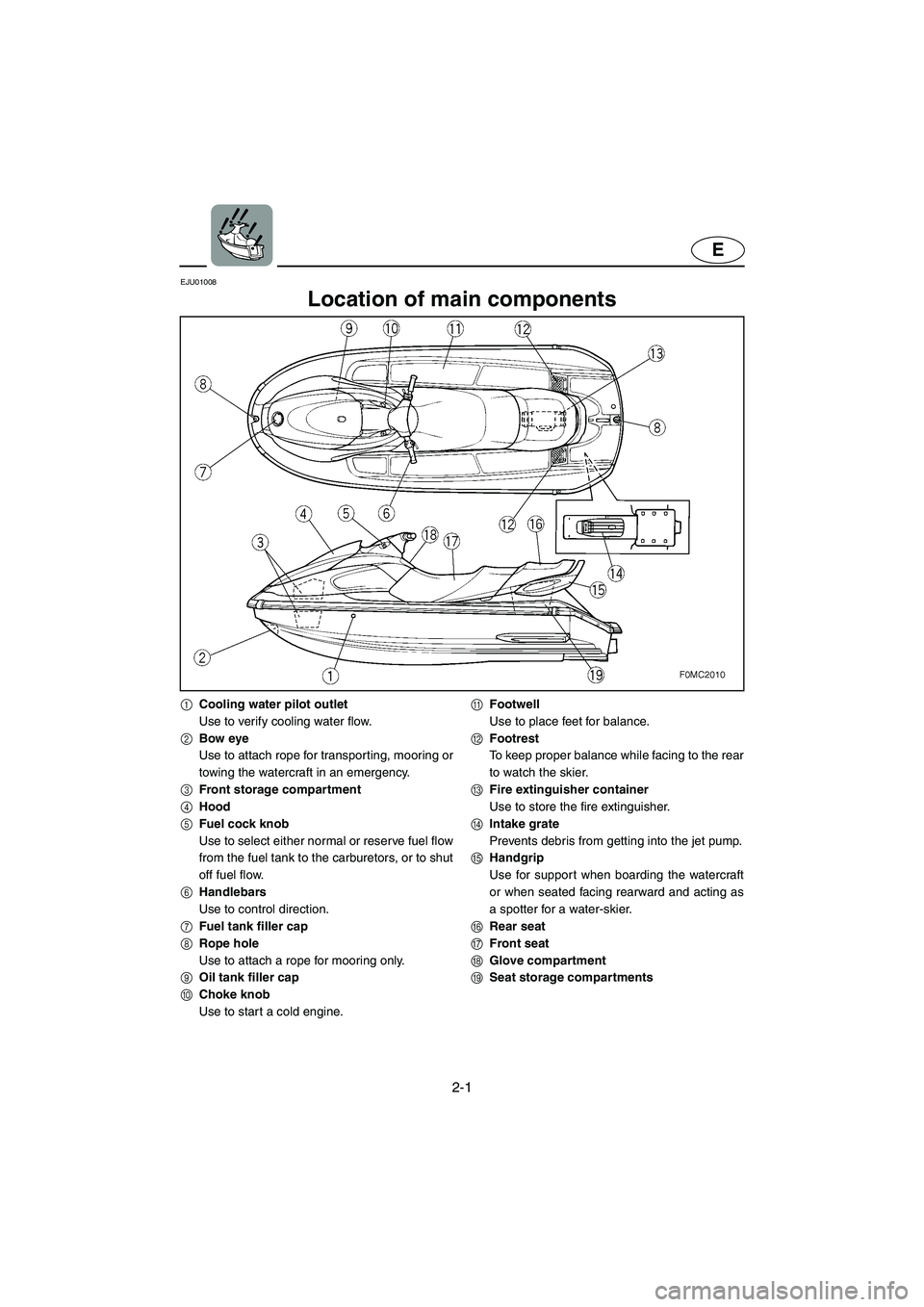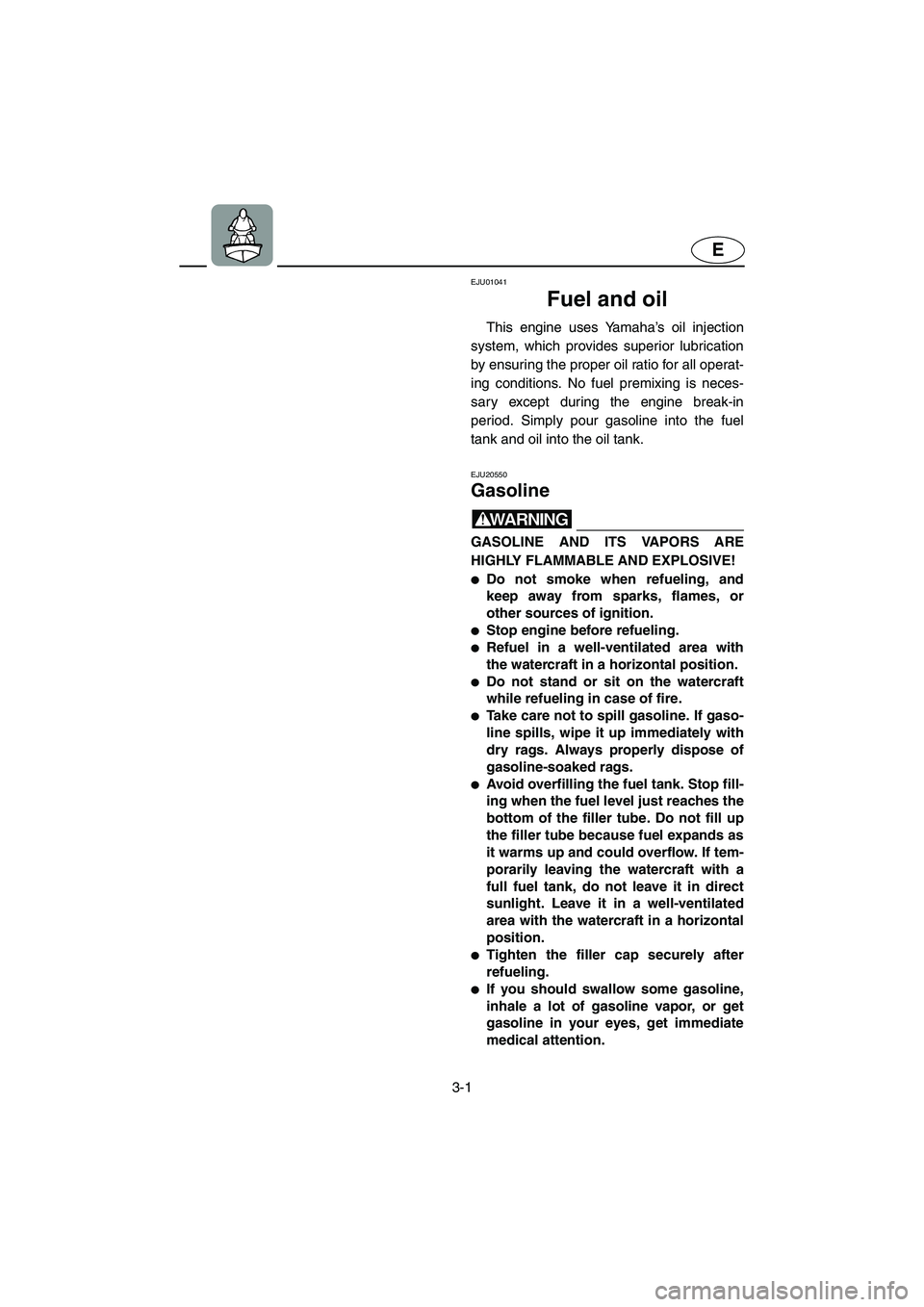Page 25 of 120

E
2
EJU01007
FEATURES AND
FUNCTIONS
Location of main components .............. 2-1
Operation of controls and other
functions ................................................... 2-4
Rear seat ................................................ 2-4
Front seat ............................................... 2-5
Hood ....................................................... 2-6
Fuel tank filler cap .................................. 2-7
Oil tank filler cap ..................................... 2-7
Fuel cock knob ....................................... 2-8
Engine stop switch ................................. 2-9
Engine shut-off switch ............................ 2-9
Choke knob ............................................ 2-9
Throttle lever ........................................ 2-10
Start switch ........................................... 2-10
Cooling water pilot outlet ..................... 2-11
Steering system ................................... 2-11
Handgrip ............................................... 2-12
Finger grip ............................................ 2-12
Engine overheat warning system ........ 2-13
Oil level warning lamp .......................... 2-14
Storage compartments ........................ 2-15
UF0M75.book Page 1 Thursday, May 29, 2003 9:53 AM
Page 26 of 120

2-1
E
EJU01008
Location of main components
1Cooling water pilot outlet
Use to verify cooling water flow.
2Bow eye
Use to attach rope for transporting, mooring or
towing the watercraft in an emergency.
3Front storage compartment
4Hood
5Fuel cock knob
Use to select either normal or reserve fuel flow
from the fuel tank to the carburetors, or to shut
off fuel flow.
6Handlebars
Use to control direction.
7Fuel tank filler cap
8Rope hole
Use to attach a rope for mooring only.
9Oil tank filler cap
0Choke knob
Use to start a cold engine.AFootwell
Use to place feet for balance.
BFootrest
To keep proper balance while facing to the rear
to watch the skier.
CFire extinguisher container
Use to store the fire extinguisher.
DIntake grate
Prevents debris from getting into the jet pump.
EHandgrip
Use for suppor t when boarding the watercraft
or when seated facing rearward and acting as
a spotter for a water-skier.
FRear seat
GFront seat
HGlove compartment
ISeat storage compartments
UF0M75.book Page 1 Thursday, May 29, 2003 9:53 AM
Page 28 of 120
2-3
E
1Silencer
Prevents water from getting into the engine
and reduces air intake noise.
2Spark plugs/caps
3Electrical box
Protects electrical components from water.
4Spark plug lead
5Muffler6Fuel tank
7Oil tank
8Fuel filter
9Flush hose connector
Use to flush the engine cooling water pas-
sages.
0Battery
UF0M75.book Page 3 Thursday, May 29, 2003 9:53 AM
Page 32 of 120
2-7
E
EJU01012
Fuel tank filler cap
To remove the fuel tank filler cap 1, turn it
counterclockwise.
NOTE:@ Make sure that the fuel tank filler cap is
properly secured before operating the water-
craft.
@
EJU01214
Oil tank filler cap
To remove the oil tank filler cap:
1. Open the hood. (See page 2-6 for hood.)
2. Turn the filler cap 2 counterclockwise.
To install the oil tank filler cap:
Install the filler cap, and then close the
hood.
NOTE:@ Make sure that the oil tank filler cap and
hood are properly secured before operating
the watercraft.
@
UF0M75.book Page 7 Thursday, May 29, 2003 9:53 AM
Page 43 of 120

E
3
EJU01040
OPERATION
Fuel and oil ............................................... 3-1
Gasoline ................................................. 3-1
2-stroke engine oil .................................. 3-2
Filling the fuel tank ................................. 3-3
Filling the oil tank ................................... 3-4
Pre-operation checks .............................. 3-5
Pre-operation check list ......................... 3-5
Pre-operation check points .................... 3-6
Operation ................................................ 3-14
Engine break-in .................................... 3-14
Starting the engine ............................... 3-16
Stopping the engine ............................. 3-19
Leaving the watercraft ......................... 3-19
Operating your watercraft .................... 3-20
Getting to know your watercraft ........... 3-20
Learning to operate your watercraft .... 3-20
Riding watercraft with passengers ...... 3-21
Starting the watercraft .......................... 3-22
Boarding and starting in deep water ... 3-24
Capsized watercraft ............................. 3-27
Turning the watercraft .......................... 3-29
Stopping the watercraft ........................ 3-31
Beaching the watercraft ....................... 3-32
Docking the watercraft ......................... 3-32
Rough water operation ........................ 3-33
Post-operation checks ......................... 3-34
Transporting .......................................... 3-36
UF0M75.book Page 1 Thursday, May 29, 2003 9:53 AM
Page 44 of 120

3-1
E
EJU01041
Fuel and oil
This engine uses Yamaha’s oil injection
system, which provides superior lubrication
by ensuring the proper oil ratio for all operat-
ing conditions. No fuel premixing is neces-
sary except during the engine break-in
period. Simply pour gasoline into the fuel
tank and oil into the oil tank.
EJU20550
Gasoline
WARNING@ GASOLINE AND ITS VAPORS ARE
HIGHLY FLAMMABLE AND EXPLOSIVE!
�Do not smoke when refueling, and
keep away from sparks, flames, or
other sources of ignition.
�Stop engine before refueling.
�Refuel in a well-ventilated area with
the watercraft in a horizontal position.
�Do not stand or sit on the watercraft
while refueling in case of fire.
�Take care not to spill gasoline. If gaso-
line spills, wipe it up immediately with
dry rags. Always properly dispose of
gasoline-soaked rags.
�Avoid overfilling the fuel tank. Stop fill-
ing when the fuel level just reaches the
bottom of the filler tube. Do not fill up
the filler tube because fuel expands as
it warms up and could overflow. If tem-
porarily leaving the watercraft with a
full fuel tank, do not leave it in direct
sunlight. Leave it in a well-ventilated
area with the watercraft in a horizontal
position.
�Tighten the filler cap securely after
refueling.
�If you should swallow some gasoline,
inhale a lot of gasoline vapor, or get
gasoline in your eyes, get immediate
medical attention.
UF0M75.book Page 1 Thursday, May 29, 2003 9:53 AM
Page 46 of 120
3-3
E
EJU01135
Filling the fuel tank
CAUTION:@ Be careful when refueling. Avoid getting
water or other contaminants in the fuel
tank. Contaminated fuel can cause poor
running or engine damage.
@
1. Open the hood and remove the front
storage compartment. Also, remove all
seats, so you can watch the fuel level.
(See page 2-6 for hood, and pages 2-4
and 2-5 for seats.)
2. Open the fuel tank filler cap, and slowly
add fuel to the fuel tank.
3. Stop filling when the fuel just reaches the
bottom of the filler tube on the fuel tank.
Do not fill into the filler tube, because
fuel could spill out.
Fuel tank capacity:
Total: 50 L (13.2 US gal, 11 Imp gal)
Reserve: 12 L (3.2 US gal, 2.6 Imp gal)
UF0M75.book Page 3 Thursday, May 29, 2003 9:53 AM
Page 49 of 120
3-6
E
EJU01048
Pre-operation check points
EJU01728
Engine compartment
Ventilate the engine compar tment before
each use.
To ventilate the engine compartment,
remove the front seat and front storage com-
partment. (See page 2-5 for front seat, and
2-15 for front storage compartment.) Allow
the engine compartment to remain open for
a few minutes to allow any fuel vapors to
escape. Also, check for loose electrical con-
nections.
WARNING@ Failure to ventilate the engine compart-
ment could result in fire or explosion. Do
not start the engine if there is a fuel leak
or a loose electrical connection.
@
EJU20570
Hull and deck
Check the hull and deck for cracks or
other damage. If any damage is found, have
a Yamaha dealer repair the watercraft.
UF0M75.book Page 6 Thursday, May 29, 2003 9:53 AM